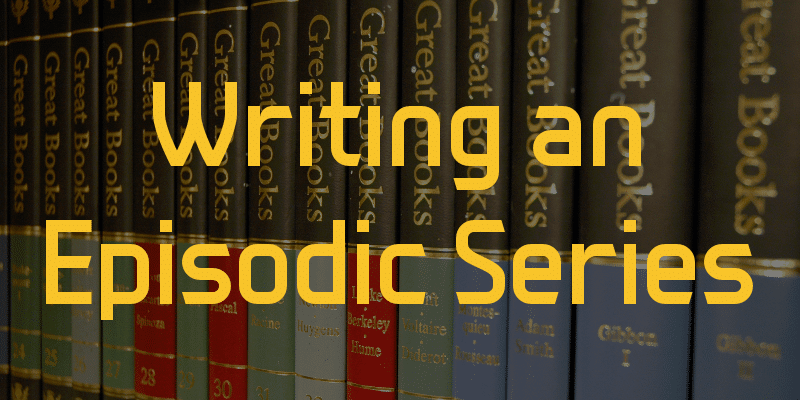I’ve written a series of long books. I’ve written one of more “standard” length books. But my current series is comprised of long novellas. I did this because I had in mind a particular pacing, a certain vibe, and a style of consumption more commonly found in television: the hourlong drama.
Advantages of the episodic style
Any series is going to have an overall theme or arc. What the episodic style changes is the reliance of one installment on the previous. You can jump in at nearly any point, and while you’ll lack the back story, you’ll still be able to experience a good story. You wouldn’t read The Two Towers without first reading Fellowship of the Ring, but you can pick up Terry Pratchett’s Discworld novels anywhere you like. This lets readers pick and choose the books that interest them, without having to “get through” earlier volumes that may not be to their liking.
As a counter example, many reader reviews advise skipping (or at least skimming) the middle Wheel of Time novels, and are advised to “push through” the early Malazan novels because the payoff is worth it. Despite the success of both series, these are weaknesses. Imagine how this would play out for a series with less renown. How many readers would stick around if the first book wasn’t to their liking, or didn’t catch their interest initially? How many great, undiscovered series have died on the vine due to a poor start or a lull?
Character development
One aspect of an episodic series is slower character development. You’re not going to see many coming-of-age series written this way, because the point of view character changing so drastically from one book to the next will throw off readers who encounter them out of order.
In many cases, my own Black Ocean series for example, character growth takes place in fits and spurts. With multiple point of view characters, each can take the limelight in turn when the story deals most directly with their development. Some characters will be more stable than others throughout the series (Carl and Mort in Black Ocean), but others are more profoundly impacted by the events around them.
Plots both long and short
Let’s consider the main plot of a story. Each volume in a series should have exactly one of these. All other plots should either be subplots, side plots, or longer arcs of which this story only tells a portion. An episodic series tends to be shorter per installment. That means that there is generally more focus on the main plot and fewer subplots. Side plots can still be sprinkled in, but are often used to keep something in the overarching plot going.
For example, if your overarching series plot is about an agency combating a criminal gang, one story plot might involve stopping a bank heist. There might be a subplot where one agent tracks the theft of a getaway vehicle. But then that agent finds out that the stolen car is owned by a suspected member of the gang, and over-insured. As an off-shoot to the heist, the agency now has a link to an insurance fraud scam that may play into future stories.
Recurring characters
Recurring characters can be fun. For readers who go through the series in order, they are a touchstone to the series. For readers who may have picked up halfway into the series, or have read them in a scattered order, it can be an opportunity to meet a fun, exciting, or love-to-hate character that they might have otherwise have missed.
Reader friendliness
This all plays into the previous point about series that have rough patches. Once you have a critical mass of reviews, each book is going to develop a reputation. One may be the slow one, or the gory one, or that one with that scene in it. Some readers may be tantalized by the risque book, while others might opt to skip it. You might get horror fans to come by just for the gory monster episode. But if your series had a single entry point, and the books didn’t make sense without it, you might lose readers with the first scenario and never gain them in the second. By making your series a collection of related episodes, you can avoid that problem and let readers pick and choose which they prefer to read.
Of course, not every series will lend itself to the episodic model. Some may be better suited to a single overarching plot that dominates every installment. Those will be best off with the traditional trilogy (or however many books) arc. Others can consider breaking off from the overall plot for solid, stand-alone installments.


0 Comments